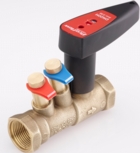Effective commissioning is no longer in the balance

The industry approach to commercial valve specification is changing. Mike Link explains how a new range of commercial valves will make life easier for specifiers and deliver a modern approach to commissioning.
The commercial valve market is extremely competitive, encompassing a wide variety of products but with no clear market leader. That is the market into which Pegler Yorkshire Group has expanded, with a range designed to make product selection and commissioning easier than ever before.
The approach to specification in the commercial valve sector has seen a marked shift in recent years. Traditionally, there has been a high percentage of ‘historical’ specification, with commissioning being a time-consuming, complex and expensive process — so any new product or system must be able to offer tangible benefits.
With our new commercial valves range, Pegler Yorkshire has tackled this issue with a new range of commissioning valves and sizing software program to go with it. Both offer serious advantages over what is currently available in terms of both product and service and when compared with more conventional products, offer the ultimate approach to commissioning.
Venturi valves offer many advantages over the more commonly used fixed-orifice plate. Flow can be measured to within ±3% across the entire range, compared to the normal ±5%.
The main feature of these valves is the venturi measuring orifice, which accelerates water flow. This increases the measured signal, ensuring the significant pressure loss common in other valve systems is recovered as it passes through. Energy is therefore not needlessly expended in pressure recovery, which makes these valves highly efficient.
The trumpet shaped design of the venturi nozzle returns a higher and cleaner signal (typically 10 to 30 kPa, depending on flow rate) without the pressure loss, making for simpler and easier commissioning.
More traditional methods of commissioning usually require a certain length of straight pipeline, free of fittings, upstream from the valve to ensure correct flow measurement. This length can vary between five and 10 pipe diameters, depending on the manufacturer’s recommended guidelines.
If the valve size is 50 mm, to give a traditional commissioning example, the length required will be 250 to 500 mm. The distance is, of course, increased if the valve is fitted immediately after the pump. Some commissioning stations also require a downstream straight length.
With venturi technology, no straight lengths of pipe are required either upstream or downstream of the measuring orifice (except immediately after a pump, which causes water turbulence). This can be a considerable advantage in a tight plant room and offers a more elegant method of commissioning for modern buildings.
Regulation and isolation are also independent, with the setting of the valve remaining unchanged when isolated. Venturi nozzles can be used with the test points in any position, even facing down.
The correct sizing and setting of commissioning valves cannot be over-emphasised if water-distribution systems are to be successfully balanced. Powerful sizing software has been developed to complement the commercial valve range. Aimed at designers and consultants the software comes with a host of features designed to help with systems design.
This software produces accurate signal data with respect to inhibitor concentrations and temperature, as these are critical in ensuring the correct flow rate has been set. The sizing software also takes into account changes in temperature and permits rebalancing at both commissioning temperature and/or the final operating temperature.
A pictorial confirmation of the selected valve is given to aid clarity and ensure the correct valve selection. MVS can be configured on the fly, with the time-saving option to apply to all unconfigured valves.
Once the parameters have been entered, the application will also suggest the best options to select. A cheaper or smaller pipe may be available, adding to the cost-effectiveness of the software and the service associated with the new range.
The new software, when coupled with the new range of commercial valves, has been designed to deliver significant time, cost and energy efficiency advantages to commissioning engineers, and Pegler Yorkshire’s ability to act as a one-stop shop will aid with supply chain partnership.
Balancing hydronic systems at an affordable cost, with products that take up less space and with software that will do much of the hard work is now within reach.
Mike Link is with Pegler Yorkshire







